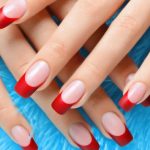 Gel vs Acrylic nail extensions, which are best?
Gel vs Acrylic nail extensions, which are best?
Hopefully this will answer some of the questions you may have regarding the differences between gel and acrylic nail enhancements. All gel enhancements mentioned below refer to hard gel which is sculpted in a similar way to acrylic, and does not refer to gel nail polish (which is classed as a soft gel).
All information in the table below refers to Artistic Rock Hard LED Gel, Artistic Putty (PolyGel) and Artistic Liquid & Powder (commonly known as acrylic). After these products have been applied to the nail, filed, shaped and buffed, it is very difficult to visibly tell the difference between the three different types of enhancements if they’ve been applied correctly.
Hard Gel Enhancements
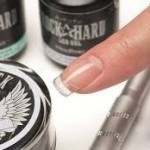 Application: A thick gel with a honey-like consistency that is applied with a brush before being cured in an LED or UV lamp.
Application: A thick gel with a honey-like consistency that is applied with a brush before being cured in an LED or UV lamp.
Smell: Odourless.
Thickness: Worn slightly thicker than acrylic.
Strength: Similar to acrylic, but not as hard.
Flexibility: More flexible than acrylic, less flexible than natural nails.
Curing: Cures under UV light or LED lamp. Less curing time than acrylic: 2 mins per coat for UV lamp and 30 seconds per coat for LED lamp.
Finish: Glossy.
Look: Looks more natural.
Immersion in water: Better than acrylic, although prolonged exposure to water can result in lifting or water being trapped under enhancement.
Durability: Two weeks or longer. Backfill and maintenance will be necessary after two weeks.
Removal: Carefully filed and buffed off, leaving a thin protective layer to grow out (cannot be soaked off).
Impact on natural nails: Same as acrylic. If removed properly, hard gel will not damage natural nails.
Liquid & Powder Enhancements (Acrylic)
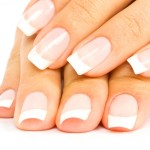 Application: A powdered form of acrylic is mixed with liquid monomer on a brush, to create a creamy bead that is then placed on the nail, blended out, and hardens without the use of a lamp.
Application: A powdered form of acrylic is mixed with liquid monomer on a brush, to create a creamy bead that is then placed on the nail, blended out, and hardens without the use of a lamp.
Smell: The monomer (liquid) has a strong smell.
Thickness: Worn slightly thinner than hard gel.
Strength: Strong and hard.
Flexibility: Hard and inflexible.
Curing: Cures when exposed to air. Longer than hard gel (takes approximately 15 mins).
Finish: Less glossy than hard gel.
Look: Looks less natural than hard gel.
Immersion in water: Can be affected and start to lift. Prolonged exposure to water can result in lifting and water being trapped between nail and enhancement.
Durability: Two weeks or longer. Backfill and maintenance will be necessary after two weeks.
Removal: Soaked off.
Impact on natural nails: Same as hard gel. If removed properly, it will not damage natural nails.
PolyGel Enhancements
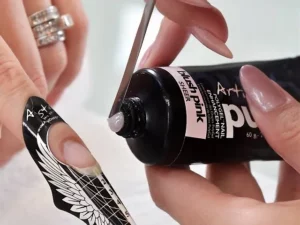 Application: A hybrid between hard gel and acrylic. A thick gel that doesn’t run or self-level (like hard gel does) and can be sculpted easily with a brush before being cured in a LED or UV lamp.
Application: A hybrid between hard gel and acrylic. A thick gel that doesn’t run or self-level (like hard gel does) and can be sculpted easily with a brush before being cured in a LED or UV lamp.
Smell: The shaping liquid has a slightly fruity scent, but is a lot less smelly than monomer (the liquid used for acrylic).
Thickness: Worn the same as acrylic.
Strength: Same as acrylic, but feels more natural.
Flexibility: More flexible than acrylic, less flexible than natural nails.
Curing: Cures under UV light or LED lamp. Less curing time than acrylic: 2 mins per coat for UV lamp and 30 seconds per coat for LED lamp.
Finish: Less glossy than hard gel.
Look: Looks the same as acrylic or hard gel, but is 23% lighter than acrylic and 16% lighter than traditional hard gel, with no sacrifice to durability.
Immersion in water: Better than acrylic, although prolonged exposure to water can result in lifting or water being trapped under enhancement.
Durability: Two weeks or longer. Backfill and maintenance will be necessary after two weeks.
Removal: Carefully filed and buffed off, leaving a thin protective layer to grow out (cannot be soaked off).
Impact on natural nails: Same as acrylic and hard gel. If removed properly, PolyGel will not damage natural nails.
To ensure that your gel or acrylic enhancements last, always use rubber gloves when you wash dishes or do any housework or cleaning that requires you to immerse your nails in water. This will help to protect the nail enhancements and prevent any water damage.
To get the most out of your manicure, you need to take care of it on a daily basis. Massage Cuticle Oil onto your nails and cuticles twice a day to ensure that your nails are well nourished, moisturised and hydrated in the correct manner. This will also help maintain your manicure as well as condition your natural nails underneath the enhancements.
Avoid picking at your nail polish or peeling off your gel or acrylic enhancements, as this will lead to damage of your natural nails and may result in you peeling off layers of nail with the polish or enhancement. If this happens your nails will become thin and soft and will be prone to tearing and breaking.
If your gel or acrylic nails do begin to lift at all, get them seen to by a professional nail technician as soon as possible. When enhancements begin to lift, germs and bacteria can get under the enhancements and this can lead to nail infections.
Always have a professional remove your gel or acrylic enhancements to prevent doing any damage to your natural nails. If gel and acrylic enhancements are applied and removed correctly by a professional, there should be no damage to your natural nails.
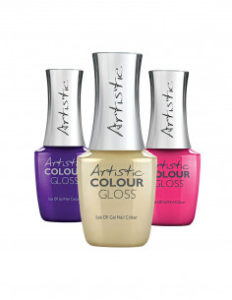 Please note that “Shellac” is a brand of hybrid gel nail polish that lasts up to 14 days. “Shellac” is not a specific nail service or nail enhancement and does not refer to any of the information mentioned above. I don’t stock or use the CND Shellac brand. All the products that I use are from the Artistic Nail Design product range, this includes Artistic Colour Gloss which is their gel nail polish.
Please note that “Shellac” is a brand of hybrid gel nail polish that lasts up to 14 days. “Shellac” is not a specific nail service or nail enhancement and does not refer to any of the information mentioned above. I don’t stock or use the CND Shellac brand. All the products that I use are from the Artistic Nail Design product range, this includes Artistic Colour Gloss which is their gel nail polish.
For more information on how to care for your manicure, please read Maintaining your Manicure.










Leave a Reply
You must be logged in to post a comment.